Hao Shen
fortiss
Cross-Level Sensor Fusion with Object Lists via Transformer for 3D Object Detection
Dec 14, 2025Abstract:In automotive sensor fusion systems, smart sensors and Vehicle-to-Everything (V2X) modules are commonly utilized. Sensor data from these systems are typically available only as processed object lists rather than raw sensor data from traditional sensors. Instead of processing other raw data separately and then fusing them at the object level, we propose an end-to-end cross-level fusion concept with Transformer, which integrates highly abstract object list information with raw camera images for 3D object detection. Object lists are fed into a Transformer as denoising queries and propagated together with learnable queries through the latter feature aggregation process. Additionally, a deformable Gaussian mask, derived from the positional and size dimensional priors from the object lists, is explicitly integrated into the Transformer decoder. This directs attention toward the target area of interest and accelerates model training convergence. Furthermore, as there is no public dataset containing object lists as a standalone modality, we propose an approach to generate pseudo object lists from ground-truth bounding boxes by simulating state noise and false positives and negatives. As the first work to conduct cross-level fusion, our approach shows substantial performance improvements over the vision-based baseline on the nuScenes dataset. It demonstrates its generalization capability over diverse noise levels of simulated object lists and real detectors.
* 6 pages, 3 figures, accepted at IV2025
Provable Affine Identifiability of Nonlinear CCA under Latent Distributional Priors
Oct 06, 2025Abstract:In this work, we establish conditions under which nonlinear CCA recovers the ground-truth latent factors up to an orthogonal transform after whitening. Building on the classical result that linear mappings maximize canonical correlations under Gaussian priors, we prove affine identifiability for a broad class of latent distributions in the population setting. Central to our proof is a reparameterization result that transports the analysis from observation space to source space, where identifiability becomes tractable. We further show that whitening is essential for ensuring boundedness and well-conditioning, thereby underpinning identifiability. Beyond the population setting, we prove that ridge-regularized empirical CCA converges to its population counterpart, transferring these guarantees to the finite-sample regime. Experiments on a controlled synthetic dataset and a rendered image dataset validate our theory and demonstrate the necessity of its assumptions through systematic ablations.
Mechanistic Independence: A Principle for Identifiable Disentangled Representations
Sep 26, 2025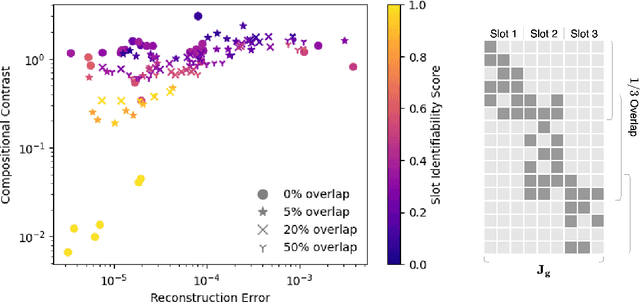

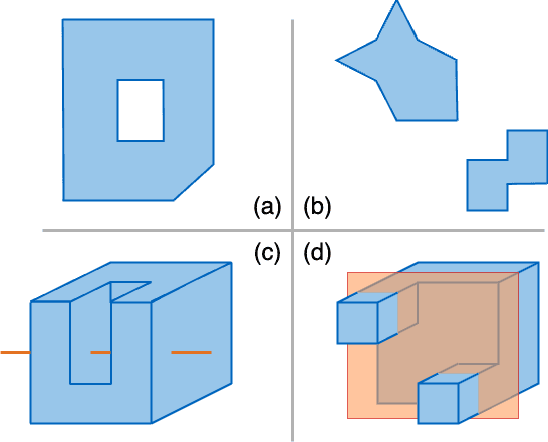
Abstract:Disentangled representations seek to recover latent factors of variation underlying observed data, yet their identifiability is still not fully understood. We introduce a unified framework in which disentanglement is achieved through mechanistic independence, which characterizes latent factors by how they act on observed variables rather than by their latent distribution. This perspective is invariant to changes of the latent density, even when such changes induce statistical dependencies among factors. Within this framework, we propose several related independence criteria -- ranging from support-based and sparsity-based to higher-order conditions -- and show that each yields identifiability of latent subspaces, even under nonlinear, non-invertible mixing. We further establish a hierarchy among these criteria and provide a graph-theoretic characterization of latent subspaces as connected components. Together, these results clarify the conditions under which disentangled representations can be identified without relying on statistical assumptions.
Resource-Efficient Adaptation of Large Language Models for Text Embeddings via Prompt Engineering and Contrastive Fine-tuning
Jul 30, 2025



Abstract:Large Language Models (LLMs) have become a cornerstone in Natural Language Processing (NLP), achieving impressive performance in text generation. Their token-level representations capture rich, human-aligned semantics. However, pooling these vectors into a text embedding discards crucial information. Nevertheless, many non-generative downstream tasks, such as clustering, classification, or retrieval, still depend on accurate and controllable sentence- or document-level embeddings. We explore several adaptation strategies for pre-trained, decoder-only LLMs: (i) various aggregation techniques for token embeddings, (ii) task-specific prompt engineering, and (iii) text-level augmentation via contrastive fine-tuning. Combining these components yields state-of-the-art performance on the English clustering track of the Massive Text Embedding Benchmark (MTEB). An analysis of the attention map further shows that fine-tuning shifts focus from prompt tokens to semantically relevant words, indicating more effective compression of meaning into the final hidden state. Our experiments demonstrate that LLMs can be effectively adapted as text embedding models through a combination of prompt engineering and resource-efficient contrastive fine-tuning on synthetically generated positive pairs.
AgentGroupChat-V2: Divide-and-Conquer Is What LLM-Based Multi-Agent System Need
Jun 18, 2025Abstract:Large language model based multi-agent systems have demonstrated significant potential in social simulation and complex task resolution domains. However, current frameworks face critical challenges in system architecture design, cross-domain generalizability, and performance guarantees, particularly as task complexity and number of agents increases. We introduces AgentGroupChat-V2, a novel framework addressing these challenges through three core innovations: (1) a divide-and-conquer fully parallel architecture that decomposes user queries into hierarchical task forest structures enabling dependency management and distributed concurrent processing. (2) an adaptive collaboration engine that dynamically selects heterogeneous LLM combinations and interaction modes based on task characteristics. (3) agent organization optimization strategies combining divide-and-conquer approaches for efficient problem decomposition. Extensive experiments demonstrate AgentGroupChat-V2's superior performance across diverse domains, achieving 91.50% accuracy on GSM8K (exceeding the best baseline by 5.6 percentage points), 30.4% accuracy on competition-level AIME (nearly doubling other methods), and 79.20% pass@1 on HumanEval. Performance advantages become increasingly pronounced with higher task difficulty, particularly on Level 5 MATH problems where improvements exceed 11 percentage points compared to state-of-the-art baselines. These results confirm that AgentGroupChat-V2 provides a comprehensive solution for building efficient, general-purpose LLM multi-agent systems with significant advantages in complex reasoning scenarios. Code is available at https://github.com/MikeGu721/AgentGroupChat-V2.
Application and Optimization of Large Models Based on Prompt Tuning for Fact-Check-Worthiness Estimation
Apr 25, 2025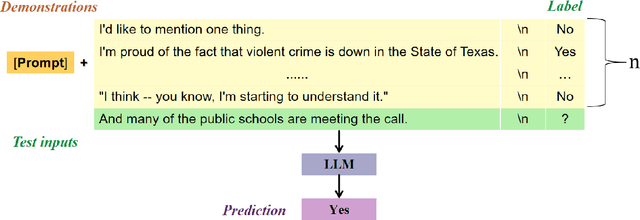
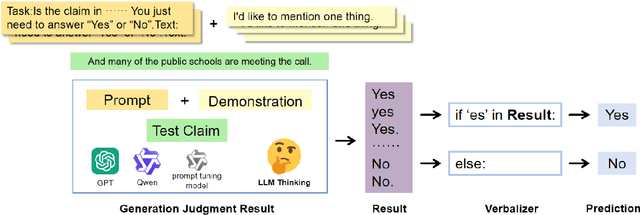


Abstract:In response to the growing problem of misinformation in the context of globalization and informatization, this paper proposes a classification method for fact-check-worthiness estimation based on prompt tuning. We construct a model for fact-check-worthiness estimation at the methodological level using prompt tuning. By applying designed prompt templates to large language models, we establish in-context learning and leverage prompt tuning technology to improve the accuracy of determining whether claims have fact-check-worthiness, particularly when dealing with limited or unlabeled data. Through extensive experiments on public datasets, we demonstrate that the proposed method surpasses or matches multiple baseline methods in the classification task of fact-check-worthiness estimation assessment, including classical pre-trained models such as BERT, as well as recent popular large models like GPT-3.5 and GPT-4. Experiments show that the prompt tuning-based method proposed in this study exhibits certain advantages in evaluation metrics such as F1 score and accuracy, thereby effectively validating its effectiveness and advancement in the task of fact-check-worthiness estimation.
PII-Bench: Evaluating Query-Aware Privacy Protection Systems
Feb 25, 2025Abstract:The widespread adoption of Large Language Models (LLMs) has raised significant privacy concerns regarding the exposure of personally identifiable information (PII) in user prompts. To address this challenge, we propose a query-unrelated PII masking strategy and introduce PII-Bench, the first comprehensive evaluation framework for assessing privacy protection systems. PII-Bench comprises 2,842 test samples across 55 fine-grained PII categories, featuring diverse scenarios from single-subject descriptions to complex multi-party interactions. Each sample is carefully crafted with a user query, context description, and standard answer indicating query-relevant PII. Our empirical evaluation reveals that while current models perform adequately in basic PII detection, they show significant limitations in determining PII query relevance. Even state-of-the-art LLMs struggle with this task, particularly in handling complex multi-subject scenarios, indicating substantial room for improvement in achieving intelligent PII masking.
Generative Multi-Agent Collaboration in Embodied AI: A Systematic Review
Feb 17, 2025Abstract:Embodied multi-agent systems (EMAS) have attracted growing attention for their potential to address complex, real-world challenges in areas such as logistics and robotics. Recent advances in foundation models pave the way for generative agents capable of richer communication and adaptive problem-solving. This survey provides a systematic examination of how EMAS can benefit from these generative capabilities. We propose a taxonomy that categorizes EMAS by system architectures and embodiment modalities, emphasizing how collaboration spans both physical and virtual contexts. Central building blocks, perception, planning, communication, and feedback, are then analyzed to illustrate how generative techniques bolster system robustness and flexibility. Through concrete examples, we demonstrate the transformative effects of integrating foundation models into embodied, multi-agent frameworks. Finally, we discuss challenges and future directions, underlining the significant promise of EMAS to reshape the landscape of AI-driven collaboration.
A Scalable Crawling Algorithm Utilizing Noisy Change-Indicating Signals
Feb 04, 2025Abstract:Web refresh crawling is the problem of keeping a cache of web pages fresh, that is, having the most recent copy available when a page is requested, given a limited bandwidth available to the crawler. Under the assumption that the change and request events, resp., to each web page follow independent Poisson processes, the optimal scheduling policy was derived by Azar et al. 2018. In this paper, we study an extension of this problem where side information indicating content changes, such as various types of web pings, for example, signals from sitemaps, content delivery networks, etc., is available. Incorporating such side information into the crawling policy is challenging, because (i) the signals can be noisy with false positive events and with missing change events; and (ii) the crawler should achieve a fair performance over web pages regardless of the quality of the side information, which might differ from web page to web page. We propose a scalable crawling algorithm which (i) uses the noisy side information in an optimal way under mild assumptions; (ii) can be deployed without heavy centralized computation; (iii) is able to crawl web pages at a constant total rate without spikes in the total bandwidth usage over any time interval, and automatically adapt to the new optimal solution when the total bandwidth changes without centralized computation. Experiments clearly demonstrate the versatility of our approach.
Drift to Remember
Sep 21, 2024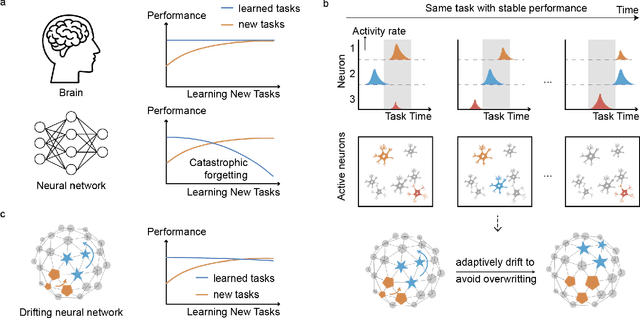
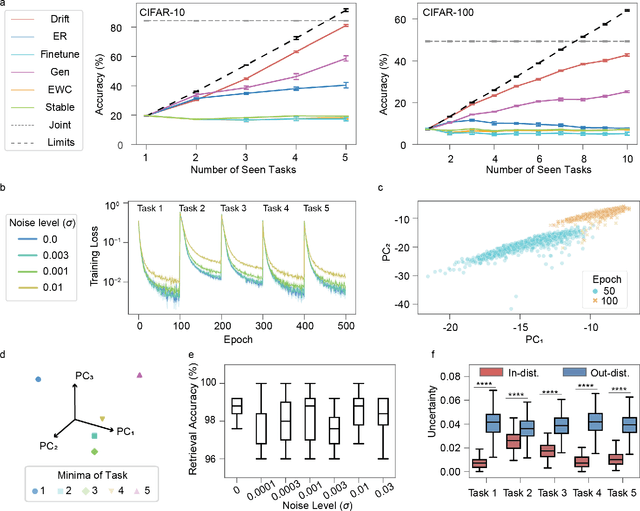
Abstract:Lifelong learning in artificial intelligence (AI) aims to mimic the biological brain's ability to continuously learn and retain knowledge, yet it faces challenges such as catastrophic forgetting. Recent neuroscience research suggests that neural activity in biological systems undergoes representational drift, where neural responses evolve over time, even with consistent inputs and tasks. We hypothesize that representational drift can alleviate catastrophic forgetting in AI during new task acquisition. To test this, we introduce DriftNet, a network designed to constantly explore various local minima in the loss landscape while dynamically retrieving relevant tasks. This approach ensures efficient integration of new information and preserves existing knowledge. Experimental studies in image classification and natural language processing demonstrate that DriftNet outperforms existing models in lifelong learning. Importantly, DriftNet is scalable in handling a sequence of tasks such as sentiment analysis and question answering using large language models (LLMs) with billions of parameters on a single Nvidia A100 GPU. DriftNet efficiently updates LLMs using only new data, avoiding the need for full dataset retraining. Tested on GPT-2 and RoBERTa, DriftNet is a robust, cost-effective solution for lifelong learning in LLMs. This study not only advances AI systems to emulate biological learning, but also provides insights into the adaptive mechanisms of biological neural systems, deepening our understanding of lifelong learning in nature.
 Add to Chrome
Add to Chrome Add to Firefox
Add to Firefox Add to Edge
Add to Edge